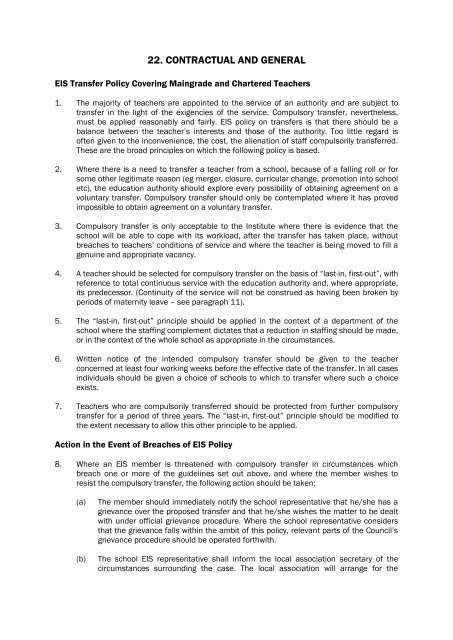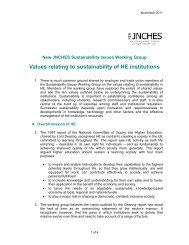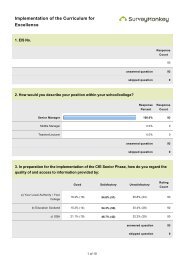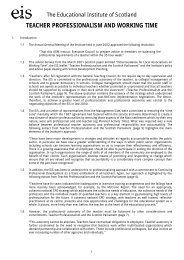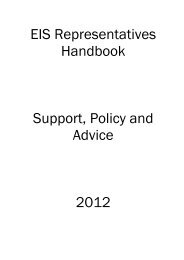22. CONTRACTUAL AND GENERAL - EIS
22. CONTRACTUAL AND GENERAL - EIS
22. CONTRACTUAL AND GENERAL - EIS
Create successful ePaper yourself
Turn your PDF publications into a flip-book with our unique Google optimized e-Paper software.
<strong>22.</strong> <strong>CONTRACTUAL</strong> <strong>AND</strong> <strong>GENERAL</strong><strong>EIS</strong> Transfer Policy Covering Maingrade and Chartered Teachers1. The majority of teachers are appointed to the service of an authority and are subject totransfer in the light of the exigencies of the service. Compulsory transfer, nevertheless,must be applied reasonably and fairly. <strong>EIS</strong> policy on transfers is that there should be abalance between the teacher’s interests and those of the authority. Too little regard isoften given to the inconvenience, the cost, the alienation of staff compulsorily transferred.These are the broad principles on which the following policy is based.2. Where there is a need to transfer a teacher from a school, because of a falling roll or forsome other legitimate reason (eg merger, closure, curricular change, promotion into schooletc), the education authority should explore every possibility of obtaining agreement on avoluntary transfer. Compulsory transfer should only be contemplated where it has provedimpossible to obtain agreement on a voluntary transfer.3. Compulsory transfer is only acceptable to the Institute where there is evidence that theschool will be able to cope with its workload, after the transfer has taken place, withoutbreaches to teachers’ conditions of service and where the teacher is being moved to fill agenuine and appropriate vacancy.4. A teacher should be selected for compulsory transfer on the basis of “last-in, first-out”, withreference to total continuous service with the education authority and, where appropriate,its predecessor. (Continuity of the service will not be construed as having been broken byperiods of maternity leave – see paragraph 11).5. The “last-in, first-out” principle should be applied in the context of a department of theschool where the staffing complement dictates that a reduction in staffing should be made,or in the context of the whole school as appropriate in the circumstances.6. Written notice of the intended compulsory transfer should be given to the teacherconcerned at least four working weeks before the effective date of the transfer. In all casesindividuals should be given a choice of schools to which to transfer where such a choiceexists.7. Teachers who are compulsorily transferred should be protected from further compulsorytransfer for a period of three years. The “last-in, first-out” principle should be modified tothe extent necessary to allow this other principle to be applied.Action in the Event of Breaches of <strong>EIS</strong> Policy8. Where an <strong>EIS</strong> member is threatened with compulsory transfer in circumstances whichbreach one or more of the guidelines set out above, and where the member wishes toresist the compulsory transfer, the following action should be taken:(a)(b)The member should immediately notify the school representative that he/she has agrievance over the proposed transfer and that he/she wishes the matter to be dealtwith under official grievance procedure. Where the school representative considersthat the grievance falls within the ambit of this policy, relevant parts of the Council’sgrievance procedure should be operated forthwith.The school <strong>EIS</strong> representative shall inform the local association secretary of thecircumstances surrounding the case. The local association will arrange for the
member to be assisted in processing at Directorate level and beyond and will adviseheadquarters who will take such other action as is appropriate in the circumstances.9. In carrying out this policy it is important that representatives should inform their localassociation secretaries of all threats of compulsory transfer of members at the earliestpossible moment. In each case the representative should supply the following information:(a)(b)(c)(d)(e)(f)(g)name of memberlength of continuous service in the school (NB for this purpose periods of illnessand/or maternity leave are not regarded as interrupting the continuity of service)whether or not the member is the “last-in” to the school or departmentlevel of promotion of the membertotal length of service with the authority or any of its constituent predecessorswhether or not the proposed transfer is acceptable to the memberthe effect of the proposed transfer on the overall staffing position in the school.10. <strong>EIS</strong> Recommendations on Calculation of Service for the Purpose of Determining Transfers.“A teacher shall be selected for compulsory transfer on the basis of “last in, first out”.Service for this purpose shall be calculated as follows:(a)(b)(c)(d)Maternity leave shall count as teaching service in full, provided the teacher returnsto service by the end of the period when the statutory right of return applies.Where for any reason the teacher has a break in service the maximum allowableperiod of that break shall be seven years. Teaching service which occurred before abreak of seven years or less shall count in full. Where the break is more than sevenyears no previous service shall be allowed.Where for any reason the teacher has more than one break in service, these breaksin service shall be aggregated. The maximum allowable aggregate shall be sevenyears. Provided the aggregate of breaks in service is less than seven years, allperiods of intervening teaching service shall count in full. Where the breaks inservice amount to more than seven years, only the service accumulated between thebreaks totalling not more than seven years in the period immediately preceding thereturn shall be credited.The aggregate of teaching service arrived at under (b) or (c) above shall be used inthe determination of the teacher eligible for compulsory transfer under the “last in,first out” principle.
Job Sharing1. Good Practice Guidance and Job Share Agreements1.1 The following “good practice guidelines” have been Institute policy for a number ofyears.Definition.- “Job-Sharing” should involve the sharing of the duties andresponsibilities of one full-time post between two people. In principle, the postshould remain essentially one job, capable of reverting to one full-time post ifrequired. Provided the job is treated as a whole, this principle would not prevent amulti-disciplinary job-share in secondary schools (eg English/French). However, itwould not be acceptable as a job sharing arrangement for one partner to work as apromoted teacher while the other partner is employed as an unpromoted teacher.1.2 Voluntary Principle.- A job-share arrangement should always be entered voluntarily,by application on the part of the teacher. An authority should neither pressure norcompel a teacher to become a job-sharer.1.3 Eligibility.- Agreement should be reached that all jobs as defined in 1.1 above,including promoted posts are eligible for sharing arrangements. This principle wouldmaximise the equal opportunities benefits of the scheme.1.4 Hours.- Normally a post should be shared on the basis of time, rather thanduties/responsibilities. Prospective job-sharers should be informed that, unless theyalready have “acquired employment protection rights”, entering a job sharearrangement could require a further period of continuous service in order to acquirethese rights. However, any move to a job-share position would not break continuity ofemployment.1.5 Communications Between Partners.- Opportunities, where possible, should beprovided for liaison between sharers and this is most readily achieved by building inan overlap period for sharers. This overlap period should be arranged within thesharers’ contractual time.1.6 Configuration of Working Week.- An agreement among the sharers and head ofestablishment on the pattern of work should be made prior to implementation of ajob sharing arrangement. Thereafter, there should be stability of timetables forsharers, subject to an annual review prior to the start of a new session. Proposals toalter the arrangement should be the subject of consultation, be implemented at thestart of a session, and be subject to an agreed period of notice.1.7 New Job-Sharers.- While a request from an existing employee to share his/hersubstantive post should normally be granted, it may be appropriate to specify aperiod of notice for submitting such a request and to have fixed starting points (egbeginning of each term). Where an authority is unable to find a partner, the requestmay have to be held in suspense.1.8 Where a Partner Leaves.- If an existing partner leaves, the remaining partner shouldbe offered the post on a full-time basis. Where a new partner is required,appointment should be in accordance with normal procedures for filling vacancies. Ifa placement cannot be found, the remaining partner should be redeployed toanother post by agreement.
1.9 Salary.- Job-sharers should be paid a pro rata element of their salary entitlement,with incremental progression determined in accordance with the provisions of theSNCT Handbook.1.10 Pension.- Prospective job-sharers should be advised to seek guidance on the effectof job-sharing on their superannuation entitlements.1.11 Conditions of Service.- Conditions of service of job-sharers should be as forpermanent full-time or part-time teachers, as appropriate.1.12 Class Contact.- Class contact should be on a pro rata basis. On a 50:50arrangement, maximum class contact is 11.25 hours.1.13 Additional Hours.- Job-sharers should undertake collegiate activities in accordancewith Part 2, Appendix 2.7 of the SNCT Handbook on a pro rata basis. This would notrequire a job sharer to return to school on days when he/she does not work.1.14 Transfer Arrangements.- Where a post is in surplus, and the “last in, first out”principle is operative, a mechanism is required for assessing the service of each ofthe sharers. Both voluntary and compulsory transfers should only be effected on thebasis of a calculation of service of each job-sharer.1.15 Holidays.- Normal holidays should apply. Public/casual holidays would be receivedwhen the sharer works on the relevant day (see paragraph 2.7 below).1.16 Training.- Job-sharers should have the same access to training and professionaldevelopment opportunities as full-time teachers.1.17 Termination.- Job-sharers should be able to resign subject to the normal conditionsof service. Where a job-sharer seeks to assume full-time working, this should be byapplication for a full-time post in the normal way (see paragraph 2.6 below).1.18 Publicity.- It is desirable that explanatory leaflets for staff are prepared, setting outthe details of the scheme and the procedures for requesting to job-share.Advertisements for posts should make clear that applications on a job-sharing basiswill receive equal consideration.1.19 Appeals Procedure.- An accelerated appeals procedure should be established forteachers who feel their request to job-share has been unreasonably refused.2. Addressing Specific Problems Associated with Job-Sharing Contracts2.1 Calculating Length of Service for Transfer Purposes.- An Employment Tribunaldecision in 1997 Hislop v Glasgow City Council [S/101761/97] established that thepractice of averaging the respective lengths of service of two job-sharers is a breachof the Sex Discrimination Act and, accordingly, most of the former Strathclydeauthorities have now revised the relevant terms of the previous standard Circular 54.For transfer purposes, therefore, the actual aggregated service of each job-sharepartner should be calculated (including mechanisms for including broken service)and used as the basis for any decisions with regard to liability for compulsorytransfer.2.2 Dealing with Changes in Circumstances of one or both Job-Share Partners.- If onejob-share partner leaves, the full-time post should first be offered to the remainingpartner. Thereafter, if the existing partner were to decline the offer of the full-time
post, a new partner should be appointed in line with the Council’s appointmentsprocedures. Should it not be possible to fill the remaining part of the job-share, theremaining partner should be offered either a permanent part-time post or redeployedto a permanent part-time or full-time contract. It is likely that, during the course of ajob-share contract, the circumstances of one or both partners may change and itshould be open, at any time, for the job-share partners to seek agreement with theemployer to an alternative configuration of hours within the job-share total. Ifagreement cannot be reached, the job-share partners and the head of establishmentshould review the arrangements in time for the start of the following term or session.Should agreement still not be possible, both partners should be offered appropriateand suitable permanent part-time appointments.2.3 Delays in Filling Vacant Job-Share Partners Posts.- It has been reported on anumber of occasions that there are, often, significant delays in filling one or other ofthe job-share portions. On this basis, time limits should be included in local job-shareagreements in order that, if another partner for the share cannot be found, theprocedures for dealing with the situation as a permanent vacancy should beinitiated.2.4 Liaison Time.- Arrangements should be put in place which allows for a period ofoverlap during normal working hours in order to permit the sharers time to consultwith each other on matters related to curricular, pastoral and other issuesassociated with their working commitments. It is suggested that class contactremission of at least two hours per week is provided for the purposes of liaison.2.5 Incremental Progression.- Will be as outlined in Part 2, Section 1 of the SNCTHandbook.2.6 Reversion to Full-Time Working.- Again, it is well established within the EmploymentTribunal system and the Courts, that failure to permit part-time or job-share working(particularly in relation to a return from maternity leave) is indirectly discriminatory.Requests for a reversion to full-time work from staff who had previously beenpermitted to work on a job-share or part-time basis will not be granted automaticallybut all such requests should be considered both seriously and timeously. It may alsobe helpful to introduce an accelerated appeals mechanism for staff who have beenrefused a reversion to full-time working in order that final decisions can be arrived atas quickly as possible. Once a decision has been taken to permit a return to full-timework, this should be implemented from the start of the following term or sessionwhichever is the earlier.2.7 Leave Arrangements and Public Holidays.- Under existing national agreements alljob-share and part-time staff are treated (albeit on a pro rata basis) in the same wayas permanent full-time staff as far as leave accrual, salary payment and otherconditions of service matters are concerned. However, a number of localassociations and Area Officers have reported problems in relation to the allocation ofpublic holidays between job-share partners. It is common practice for one partner towork at the beginning of a week (ie up to Wednesday lunch time) and for the otherpartner to complete the remainder of the week. However, with the preponderance ofpublic holidays falling on a Monday, it is possible that one partner in a 50:50 jobsharewill actually receive less in terms of leave entitlement than the other. There areno straightforward solutions to this problem which keep intact important pro rataelements of existing national agreements covering salary and leave accrual rights.There are, however, two potential solutions to this problem which would require theagreement of the job-share partners, school management and the local authority.
(a) Agreement could be reached at the commencement of each session whichwould allow for an even or pro rata allocation of public holidays between thepartners. In other words one partner would be required to “cover” for the otherpartner on a relatively small number of days during the course of a year toestablish a proper balance.(b)In a 50:50 job-share situation the actual fraction of annual salary entitlementpaid to each job-sharer could be amended slightly to accommodate the smalldifference in working days (or hours) during the course of that salary year.2.8 Absence Cover.- Where one job-share partner is absent from work (for whateverreason) the other partner should be offered the opportunity of covering for his/herpartner. If the offer is accepted the covering partner should be paid for thisadditional work on the appropriate daily or hourly rate for temporary staff.


